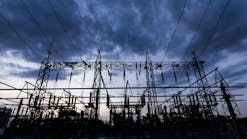By Jason Lander, S&C Electric Company Vice President, EMEA and Asia Pacific
The rolling hills, fertile landscape, and temperate climate are signature features of the United Kingdom. Picturesque farms and green fields stretching over the horizon, historic estates perched above valleys, and charming quaint towns make the landscape postcard worthy.
However, delivering reliable power within these areas can be difficult. Electrical lines stretch for miles over rolling fields, and these idyllic settings are prone to heavy rainfall and windy conditions, creating numerous temporary faults along rural lateral lines. And when combined with other common outage causes, such as local wildlife, power interruptions can become a routine inconvenience for residents.
Western Power Distribution (WPD) is tasked with providing reliable and resilient electricity to the 8 million people that call these areas home. With 136,700 miles of lines, the utility is one of the United Kingdom’s largest distribution network operators, with a coverage area roughly the size of West Virginia. The sheer size of the territory and population make it expensive and time-consuming to respond to outages.
Often, temporary faults cause permanent outages that require WPD to dispatch a repair crew. With power offline for hours, customer satisfaction can decline. Each site visit costs hundreds of dollars, leading to increased operation and maintenance (O&M) costs and a negative impact on reliability metrics.
WPD was eager to find a new way to resolve these temporary faults that would align with its vision of modernizing the grid and creating a more sustainable energy future—without significantly raising its customers’ rates.
New Grid Framework
While exploring its options, WPD looked for solutions to meet performance-based incentives from Ofgem, the British energy regulator. Established to solve future challenges facing utilities, including addressing reliability issues, Ofgem’s incentive framework, called RIIO (Revenue = Innovation + Incentives + Outputs), measures performance in six categories, or outputs. However, the outputs are not weighted evenly, with overall grid reliability given the most financial weight.
Using the framework in its rate-setting process, Ofgem motivates utilities to create long-term solutions by rewarding them with increased revenue or, inversely, by penalizing them if the investment fails to meet performance-based targets. The main objective is to help utilities build a modern grid able to withstand growing environmental challenges, such as increasingly severe storms, while also handling greater energy demand throughout the country.
To maximize the benefits of the incentive framework, one critical area WPD chose to concentrate on was improving reliability by reducing customer interruptions and customer minutes lost. After setting the targets, WPD developed a business plan to meet its performance-based goals, including boosting customer satisfaction, reducing O&M costs, and improving overall grid reliability. Accomplishing these critical goals meant the utility needed help to address permanent outages caused by temporary faults along its fuse-protected lateral lines.
Implementing the Solution
To curtail unnecessary outages, WPD needed to upgrade the technology on its system. The utility turned to S&C Electric Company to explore implementing an advanced lateral protection solution, the TripSaver II Cutout-Mounted Recloser, to meet the utility’s goals.
Because up to 80% of overhead distribution faults are temporary, the single-phase recloser would help prevent such faults from becoming permanent outages. The TripSaver II recloser accomplishes this by testing the line when fault current is detected and closing back in once the source of the temporary problem, such as a loose branch, goes away.
This drastically reduces customer interruptions and customer minutes lost, trims O&M costs by preventing costly site visits, and most importantly keeps customers’ power on. For households experiencing multiple outages throughout the year, this is a transformational outcome.
Becoming the first United Kingdom utility to deploy the TripSaver II recloser, WPD tested the single-phase device and proceeded with a one-year pilot of 27 TripSaver II reclosers in 10 separate South-West England locations. WPD chose these locations because they represented a mix of lateral lines that historically had experienced many temporary faults along with various average-performing laterals.
Successful Pilot
WPD experienced immediate results, and the pilot verified the device’s ability to mitigate the impact of temporary faults at these trial sites. Throughout the 12-month trial period, the TripSaver II reclosers consistently prevented temporary faults from becoming permanent outages, reducing WPD’s operating costs and positively impacting customer reliability.
In total, the 27 TripSaver II reclosers used in the pilot cleared 16 temporary faults that previously would have become permanent outages, reducing the number of customers directly impacted and preventing the utility from having to send crews to the sites for repairs. Avoiding these site visits saved approximately 480 miles of travel and reduced about 328 pounds of carbon emissions, helping WPD progress toward its sustainability goals and implement solutions to build a greener grid. The overall reduction in fossil fuel consumption also aligned with the UK government’s ambitious goal to achieve net-zero carbon emissions by 2050.
Based on incentive rates Ofgem set, WPD’s cost benefits from reducing customer interruptions and minutes lost, as well as avoiding site visits, totaled US$319,000 (£259,300) for the one-year trial period. The TripSaver II reclosers proved to be effective in the field with a rapid return on investment. The average payback period for the TripSaver II reclosers installed on WPD’s rural lateral lines was only 2.1 months. Because of these positive results, WPD plans to install more single-phase reclosers across its system.
WPD’s system development manager, Paul Jewell, said the TripSaver II reclosers continue to prove their value. “The trial showed benefit to customers and, as a result, we have included the use of this technology within our business plan. This will improve service to our customers and reduce fault impacts,” Jewell said.
WPD is pioneering a modern grid in the United Kingdom and setting an example of how innovative technologies can improve outcomes for both utilities and their customers. As the energy industry faces more complex challenges from electrification and digitization, WPD’s proactive investments will help the utility prepare for the future and optimize its grid operations to provide reliable and resilient power for decades to come.


